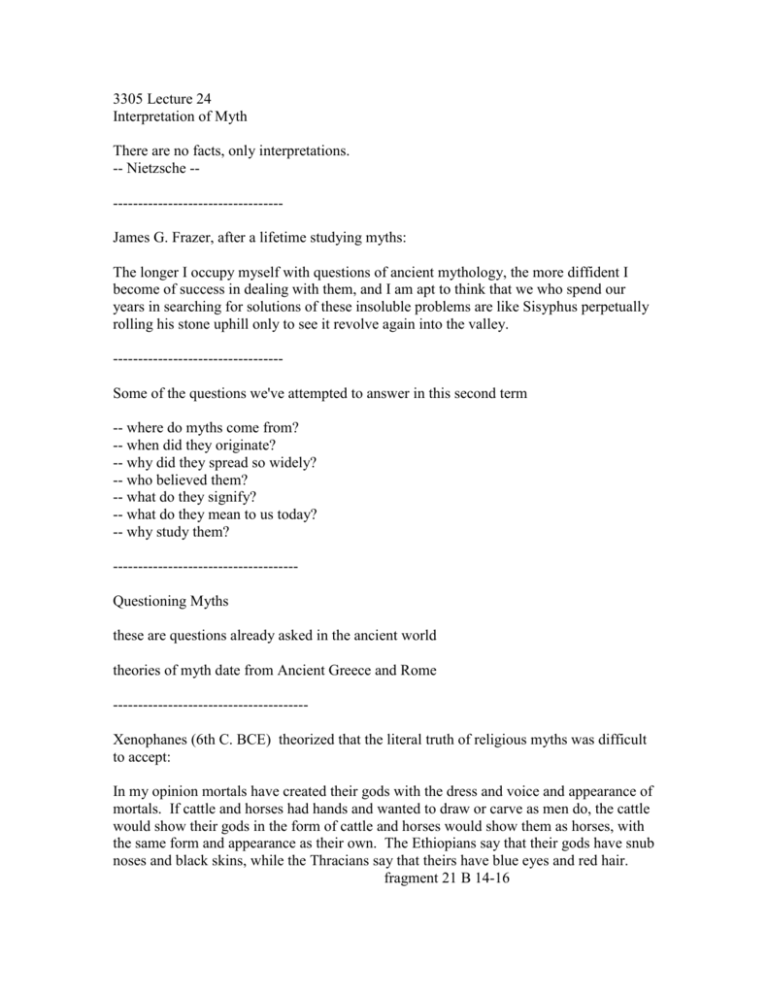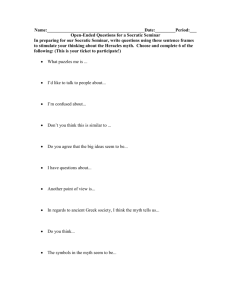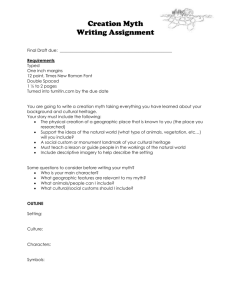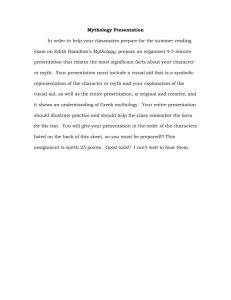3305 Lecture 24
advertisement

3305 Lecture 24 Interpretation of Myth There are no facts, only interpretations. -- Nietzsche ----------------------------------James G. Frazer, after a lifetime studying myths: The longer I occupy myself with questions of ancient mythology, the more diffident I become of success in dealing with them, and I am apt to think that we who spend our years in searching for solutions of these insoluble problems are like Sisyphus perpetually rolling his stone uphill only to see it revolve again into the valley. ---------------------------------Some of the questions we've attempted to answer in this second term -- where do myths come from? -- when did they originate? -- why did they spread so widely? -- who believed them? -- what do they signify? -- what do they mean to us today? -- why study them? ------------------------------------Questioning Myths these are questions already asked in the ancient world theories of myth date from Ancient Greece and Rome --------------------------------------Xenophanes (6th C. BCE) theorized that the literal truth of religious myths was difficult to accept: In my opinion mortals have created their gods with the dress and voice and appearance of mortals. If cattle and horses had hands and wanted to draw or carve as men do, the cattle would show their gods in the form of cattle and horses would show them as horses, with the same form and appearance as their own. The Ethiopians say that their gods have snub noses and black skins, while the Thracians say that theirs have blue eyes and red hair. fragment 21 B 14-16 ----------------------------Xenophanes One god is greatest among gods and men, but his appearance and thought are nothing like ours. frag 21 B 23 ------------------------------------------Classical interpretation Theogenes (6th C. BCE) is said to have been the first to develop the allegorical interpretation of Classical mythology particular psychological attributions came to be ascribed to particular gods and goddesses: Athena: Ares: Aphrodite: Hermes: rational thought irrational violence desire reason -----------------------------------Classical interpretations In Hellenistic times, the Stoic philosophers refined this allegorical interpretation -------------------------------Plato (circa 4th C. B.C.) disapproved of myth and banned it from his perfect world felt that it too-easily misled people Admitted that myths were worth telling (And told a few himself (Atlantis, for one)) but only if one paid attention to the profound symbolic truth beneath the popular surface ---------------------------------Plato's theories were further refined by the Neoplatonists *Detail from Raphael's School of Athens showing Plato and Aristotle --------------------------------------Medieval theories Medieval thinkers adopted and adapted both the early allegorical interpretations and the Platonist theories of symbolism in mythology * Tintern Abbey in Wales ------------------------------------ Medieval theorists applied these theories to the Bible as well: The Song of Songs -- lusty celebration of physical love between a man and a woman explained by certain church fathers as the story of god's love for his church (actually descended from secular Egyptian Love Poetry) -------------------------------Renaissance followers of Platonic interpretation went even further: they declared that the more bizarre and violent the surface, the more truth was represented by the story that truth went to the trouble of hiding itself in just such bizarre and shocking array to keep off the dilettantes only those who earnestly sought the truth would not be put off ---------------------------------------Enlightenment institutional power of the church waning due to political and social changes traditions more subject to re-examination including myths (both Classical and Biblical) ----------------------------------In the Enlightenment Myth came to be viewed as symbolic of error Symbolic of man's ignorance in a time before scientific enquiry (and thus interpreted mostly in terms of savagery and ignorance) ----------------------------------------In the Enlightenment The emphasis shifted from the interpretation of myth to a study of its origins *Pygmalion and Galatea Jean-Louis Gerome -------------------------------------Giambatisto Vico (circa 1700) Vico attempted to understand the place of myth and legend in human history He posited three ages of history which repeat themselves in a spiral (always the same but differentiated by particular circumstances) ------------------------------------The first age is an age of Gods creation of the world) (Age of the struggle against Chaos -- birth of the gods -- *Hieronymus Bosch ----------------------------------The second age is an Age of Heroes -- emerging social institutions -- civilization -- oral culture -- myths and legends descend (Age of Gilgamesh and Odysseus) ------------------------------------- The third age is an Age of Man -- rationalization -- rise of philosophy and science (this is where we are) *Leonardo DaVinci ------------------------------------He argued that the developments of history can only be understood through a study of the changing expressions of human nature through language, myth and culture. ------------------------------Sir James Frazer (circa 1930s) Frazer developed a theory of myth as ritual He insisted that the origins of religion are closely tied to myth ------------------------------------ritual first used as a sort of "magic" to coerce impersonal powers to do man's bidding obvious that the magic was often ineffective led to the birth of religion: the propitiation of gods ---------------------------------religion characterized the forces as personal rather than impersonal (felt safer, I imagine) --------------------------------Bronislaw Malinowski (circa 1940s) (founder of social anthropology) Malinowski developed a different explanation: -------------------------------The purpose of myth was to justify and validate existing social and economic structures and legal and political practices Example: kingship was lowered from heaven -------------------------------- Myth was important because of its social function -- the ways in which it helped people live with themselves, each other and god led to functional theories of mythology ---------------------------------Linguistic Theories of Myth Linguistic theories appeared at the turn of the century -- followed from the discovery that almost all European languages are descended from Proto-Indo European -------------------------------Scholars began to look for the general shapes which underlay all the particular shapes of myth led to study of comparative mythology ----------------------------------Oedipus *Dominique Ingres 1808 -----------------------------------Freud considered myth a byproduct of the individual psyche related to dreams -- both are universal phenomena both deal in symbols The language of one provides a clue to the language of the other --------------------------------Psychoanalytic theory The Psychoanalysts viewed myth as the collective and recurrent dreams of the race Interpreted the Myth of Oedipus as a collective representation of the sexual conflict experienced by all males -- they desire their mother and want to kill their father -------------------------------------By extension.. stories that tell of slaying dragons and rescuing fair maidens are really representations of lust for the mother and hatred for the father allegory in another guise --------------------------------------Carl Jung (circa early 20th C) also explored the idea of the unconscious developed the idea of the collective unconscious individual consciousness is just a bay or inlet on the great ocean of the collective unconscious -- partakes of the same symbolism ----------------------------------------dreams are an expression of the wisdom of the unconscious not just our individual unconscious, but the collective unconscious -- taps into the deep imagery which goes back to the beginning of mankind ------------------------------------"As far as we can discern, the sole purpose of human existence is to kindle a light in the darkness of mere being." -------------------------------------Claude Levi-Strauss (circa 1970s) Developed the theory of structuralism. The most recent interpretive framework for looking at myth ---------------------------------The meaning of a traditional story or myth lies not in its words but rather in its structure Myths are not `justifications' - but rather attempts to overcome contradictions Myths are not to be deciphered - but rather compared with other myths The meaning is not in the content - but rather in the shape -----------------------------------The form is the meaning is the form --------------------------------Joseph Campbell.... He describes the mid-life crisis this way: "getting to the top of the ladder, only to discover that it was leaning against the wrong wall." --------------------------------"The latest incarnation of Oedipus, the continued romance of Beauty and the Beast, stand this afternoon on the corner of 42nd Street and Fifth Avenue, waiting for the traffic light to change." ----------------------------------








